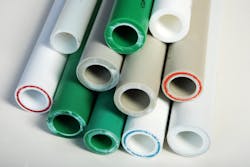Evolution of the Water Pipe Market & Material Uses
Jim Goddard is owner of and consultant for JimGoddard3 LLC. Goddard can be reached at [email protected]. Harvey Svetlik is global polyethylene pipe consultant for Harvey Svetlik Consulting. Svetlik can be reached at 817.501.9260
undefinedWater is essential to life, and good quality water, readily available determines the growth of cities and nations. With the world population growing from 1 billion people in 1850 to more than 8 billion today (2021), water demands have grown proportionally.
Water collection and transmission from distant sources to population centers has evolved from the early canals and aqueducts to extensive pipe systems. Much of these early water distribution systems in the U.S., and throughout much of the world is 75 to 100 years old or older. These systems leak badly (in excess of 20% of all processed water is lost through leakage in municipal systems throughout the U.S., and in some cities as much as 40% is lost); and breaks are common; approximately 250,000 water-main breaks are recorded throughout the U.S. per year.
The History of Water Pipe Materials in the U.S.
Early pipe materials used for water distribution included lead, clay, and wood, both wood staves and hollowed trees. Wood pipe is still found in municipal systems. There are still lead pipe service lines in the hundreds of thousands throughout the U.S. as well. Cast iron pipe began being used in the early 1800s, when Philadelphia installed cast iron pipe to replace wood pipe as early as 1810. Over time various linings and coatings were used to reduce corrosion of the cast iron, including cement or coal tar linings and coal tar coatings.
Ductile Iron was introduced in AWWA Standards in 1965 , and largely began replacing cast iron because of higher strength and ductility. Ductile Iron still required an interior lining and external corrosion protection. It is common today to install ductile iron pipe inside a polyethylene sleeve.
The most common water main sizes are from 6 inches (150mm) in diameter to 24 inches (600mm) in diameter, with service connections to homes and businesses varying from 1 inches (25.4mm) to 6 inches (150mm). This article will primarily focus on that portion of the market and industry. Installation practices range from traditional cut and cover to relining existing pipe and directional drilling. Pipe type selection may be determined by the installation method required. Many of the newer pipe developments address these practices.
Modern Pipe Materials & Technology Advancements
In the last 50 years there have been significant improvements and changes in water pipe types that serve to address these issues. The market share of pipe materials has changed, reflecting changing needs and construction or installation methods. The greatest change has been the introduction, use, and acceptance of non-metallic material for water pipe applications, particularly PVC (polyvinyl-chloride) and HDPE (high-density polyethylene). These pipe types and materials have improved over the past years.
Plastic pipe types began being used widely after the end of World War II. Many of these systems are still in use today and performing well. Compared to the products produced today, those pipes were primitive. Improvements in raw material, joints, and fittings have made these systems very durable and the joints very tight. Most of these improvements are presented in the current ASTM standards under ASTM F17, Plastic Pipe. and AWWA C906 / C901 Water-Main and Water-Service pipes.
Plastic Pipe Technology Advancements
PVC pipe has been primarily produced with gasketed bell and spigot joints. Recent developments have lead to butt-welded joints, similar to the HDPE practice.
Polyethylene pipe has seen the vast changes in material, joints, available diameters, and performance. In terms of the PE resins used to manufacture PE pressure pipe, the resins utilized in the 1970s would likely no longer pass the performance requirements of non-pressure pipe, such as sewer and culvert pipe, much less approach the capabilities of current resins in terms of chemical resistance, initial strength, long-term strength, or impact resistance. Yet, miles of pipe produced to the earlier standards are still performing very well in water service.
Possibly the single greatest change to the water pipe distribution systems was the development of the butt fusion equipment to produce pipe that is virtually joint-less. Bell and spigot joints have occasional failure issues from poor installation, gasket failures, cracking from over-belling. They also require a larger diameter at the joint, which reduces the slip-lining capability. Butt fusion joints are no larger than the pipe, and can be used to reline existing pipe or in directional drilling installations. These joint failures are extremely rare, much less common than bell and spigot joints.
For water service pipe, AWWA C906 / C901 PE4710 HDPE pipe is widely specified for urban water distribution systems for horizontal directional drilling, boring, pipe-bursting, compression-fit pipe lining, trenchless installation practices, and localized repairs.
With water systems now approaching the end of their effective lives, with leakage and water loss a bigger concern, and actual pipe failures increasing every year, the need to address this infrastructure is becoming more critical. New systems will rely on more plastic pipe products for their durability, water-tightness, and long-term strength.
